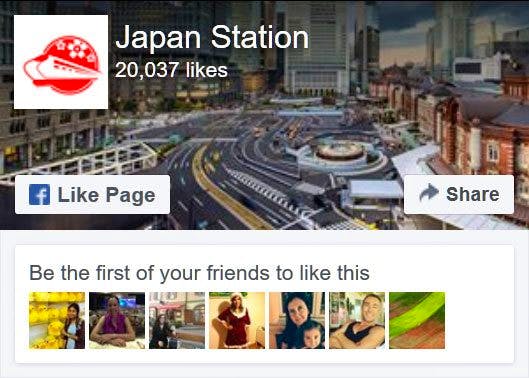Sensoji Temple in Asakusa is the oldest and most famous temple in Tokyo with a history going back 1,400 years. This temple is dedicated to Kannon, the Buddhist goddess of mercy, and it is incredibly popular with millions of people visiting every year.
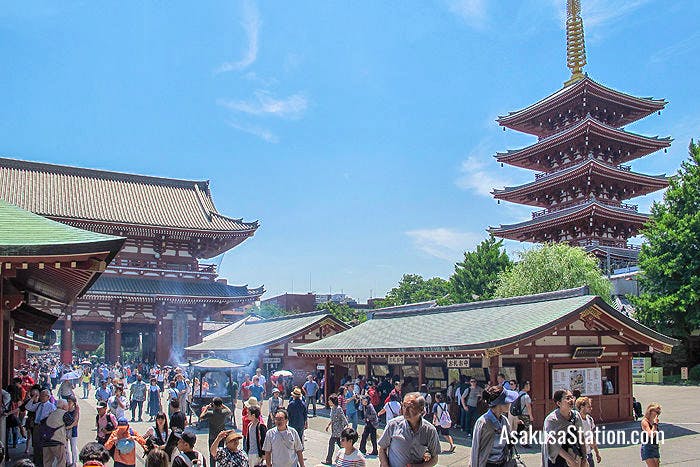
A view of Sensoji’s Five-storied Pagoda and Hozomon Gate
The district of Asakusa and Sensoji Temple are so deeply connected that their names are written using the same Chinese characters: 浅草, which means “shallow grass”. “Senso” is the Chinese pronunciation, and “Asakusa” is the Japanese pronunciation. When Sensoji was first founded, the Asakusa area was not a busy town like today, but a wild grassland where very few people lived. Thanks to Sensoji however, Asakusa became a lively center of pilgrimage and trade. The temple is the true heart of the town.
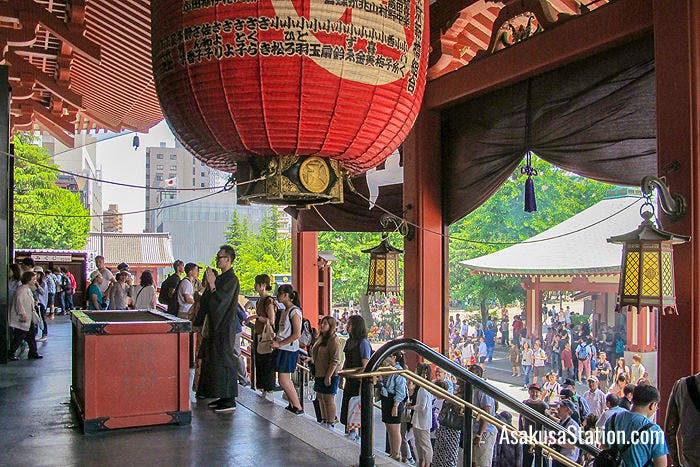
Visitors praying at the Main Hall of Sensoji Temple
The Story of Sensoji
The story of Sensoji Temple goes back to 628 when two brothers, called Hinokuma Hamanari and Hinokuma Takenari, went fishing in the Sumida River. That day they caught no fish, but they did find an unusual object in their net: a small golden statue. The simple fishermen did not understand the statue’s value, and they actually threw it back into the water! However, even though they moved their boat and threw the statue away many times, the statue kept coming back to their net. In the end they took the mysterious statue and showed it to their local chief, Haji no Matsuchi. He recognized the statue as Kannon the goddess of mercy, and together the three men made a small grass hut to enshrine the statue. Later on, Haji no Matsuchi made his own home into a temple for the statue, and this was the start of Sensoji Temple.
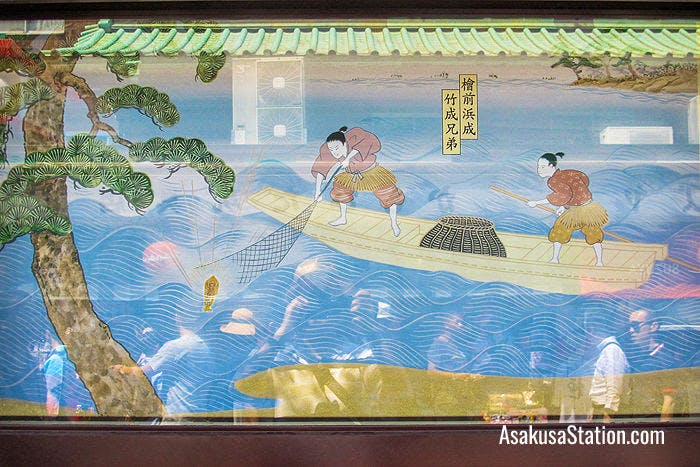
An illustration at Sensoji shows how the two brothers first found the statue
Another legend says that three days after the statue appeared, a golden dragon was seen flying down from heaven, and so another name for Sensoji is “Kinryuzan”, which means “Golden Dragon Mountain”. To commemorate these events a Golden Dragon Dance (called Kinryu-no-Mai) is held at the temple every year on March 18th.
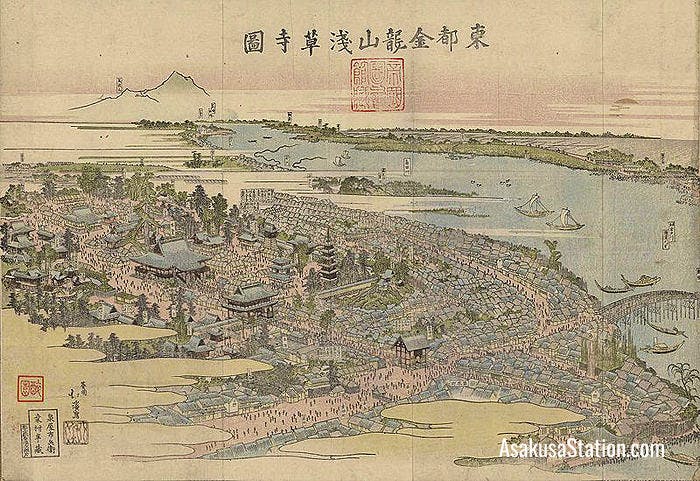
A print by Totoya Hokkei shows Sensoji Temple in 1820 (Public Domain)
Sensoji was destroyed by fires and natural disasters and then rebuilt several times over its 1,400 year-old history. However, after it was rebuilt in 1649, the Main Hall of the temple managed to survive for almost 300 years. This was despite repeated outbreaks of fire in the neighborhood, and the hall even survived the Great Kanto Earthquake of 1923. However, on March 10th 1945, the entire temple was completely destroyed in the firebombing of Tokyo.
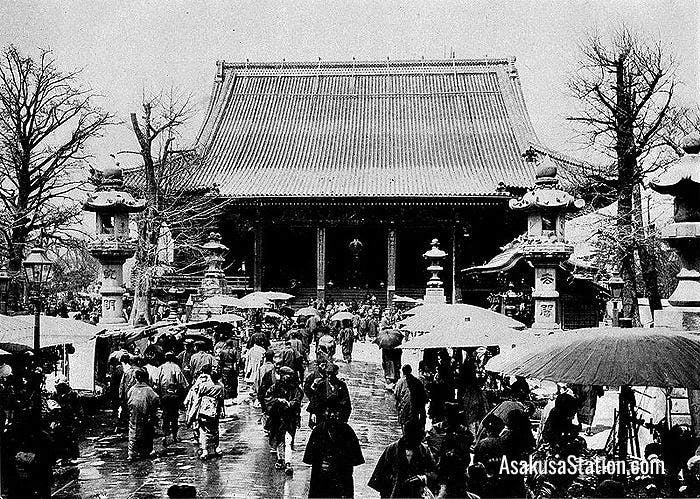
How the Main Hall looked in 1910 (Public Domain)
Rebuilding the temple, after the war was over, was an important symbol of the Tokyo’s rebirth. With the aid of donations from all over the country reconstruction of the temple’s Main Hall began in 1951 and was completed in 1958. Other buildings gradually followed, such as the Kaminarimon Gate in 1960, the Hozomon Gate in 1964, and the Five-storied Pagoda in 1973. Today, the temple remains incredibly popular and receives around 30 million visitors each year.
The Main Buildings
The main entrance of Sensoji is the Kaminarimon (literally “Thunder Gate”) which with its enormous red and black chochin lantern has become a popular symbol of Asakusa. This is the outer gate of the temple and it enshrines two statues of the gods of the wind and thunder. The gate was first built around the year 942, but burned down many times. After it was destroyed by fire in 1865, it wasn’t rebuilt for another 95 years, but in 1960 both the gate and its statues were fully restored. To learn more about this famous landmark, see our article: Kaminarimon – Asakusa’s Thunder Gate.
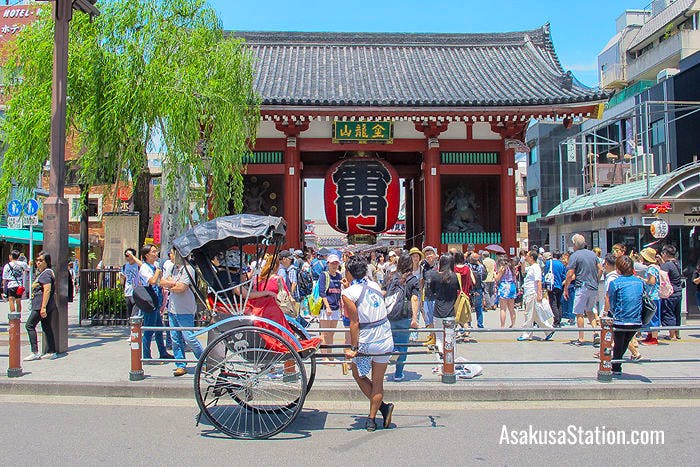
A rickshaw driver stops to admire the Kaminarimon Gate
After passing through the Kaminarimon, visitors enter the Nakamise shopping street. This is the approach road to the temple’s main buildings and for 250 meters it is lined on both sides with traditional souvenir shops. To learn more about the unique local products, snacks and sweets that are available here, see our article: Nakamise Shopping Street.
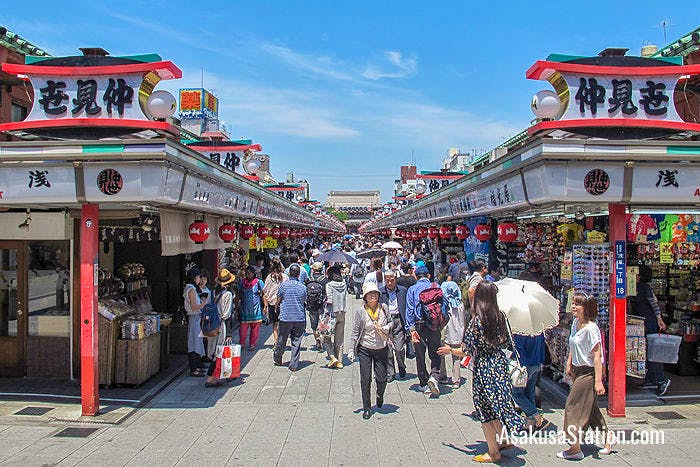
The entrance to Nakamise shopping street
The Hozomon (literally “Treasure House Gate”) stands at the northern end of Nakamise. This massive two-story structure is 22.7 meters high, 21 meters wide, and 8 meters across from front to back. This is the inner gate of the temple. The Hozomon was first built in 942, but burned down many times. The current gate dates from 1964 and is made of fireproof materials, so it is used to store the temple’s most treasured items.
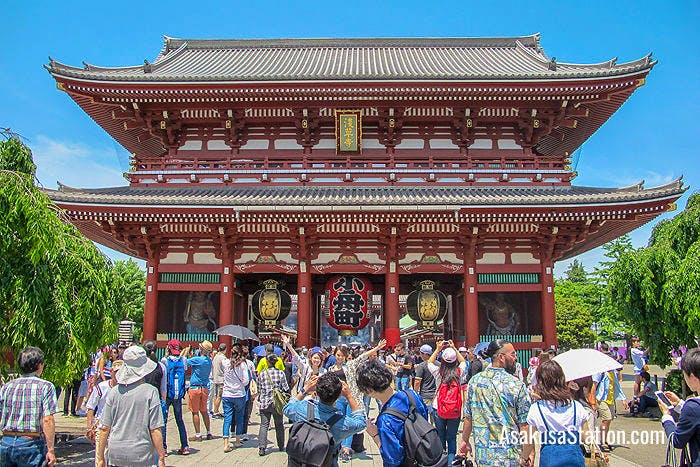
The Hozomon
On the left and right side of the gate are two wooden Nio statues, fierce looking guardian spirits who protect Buddhist values. In the past the gate was called the Niomon after these statues, before being renamed the Hozomon.
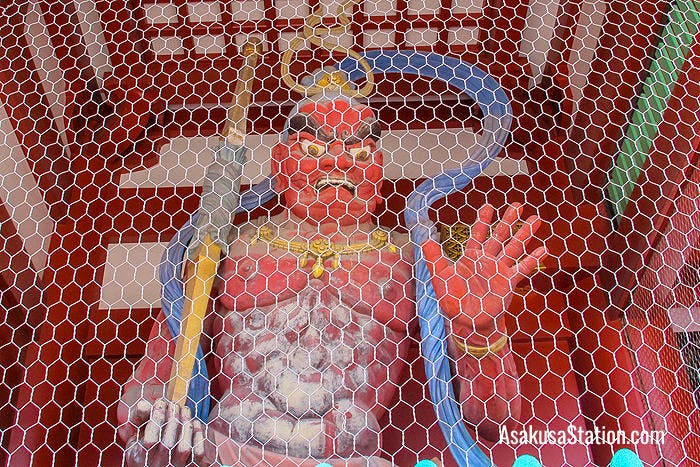
One of the Nio statues
Three large chochin lanterns also hang inside the gate. The central lantern is the largest and is 3.75 meters high, 2.7 meters wide, and weighs 450 kilograms. This lantern has the characters 小舟町 (Kobunacho), written on it, because this is the name of the Tokyo district that donated the lantern in 2014.
On the other side of the gate are two giant straw sandals. The size of the sandals is meant to show how big and tough the guardian Nio spirits are, and so scare away any evil spirits. These sandals are replaced every ten years by Murayama City in Yamagata Prefecture and the most recent sandals were donated in 2018. The sandals are 4.5 meters high, 1.5 meters across, weigh 500 kilograms, and it takes 800 people 18 months to weave them.
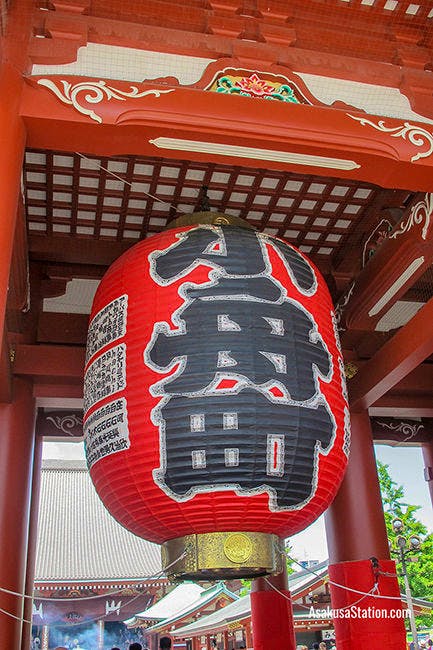
The chochin lantern at the center of the gate
After passing through the Hozomon Gate, visitors enter the main part of the temple complex with the Main Hall in front of them and the five-storied pagoda on the left.
The Main Hall is called the Hondo in Japanese, and it is also called the Kannon-do because this is where the statue of Kannon is enshrined. However, the statue is not actually on display. The original statue, which was found in the Sumida River in 628, is considered so holy that it has been kept hidden from public view since 645. It seems that every time somebody tries to look at the statue something really bad happens, so maybe it is a good thing it is kept hidden. There is also a substitute statue however, which was carved by Priest Ennin in 857, and this is displayed to the public just once a year on December 13th at 2.00 pm. Both statues were apparently saved from the firebombing in 1945.
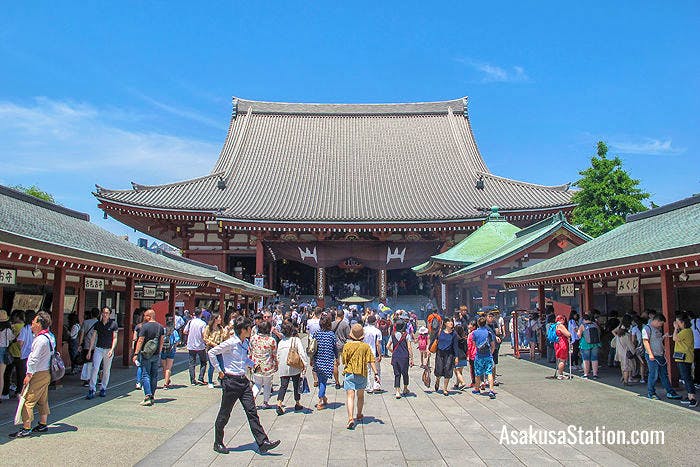
The Main Hall
The current Main Hall was built in the same style as the previous building, but with sturdier modern materials such as ferroconcrete. And in 2010 the traditional hip-and-gable roof was retiled with light-weight titanium tiles.
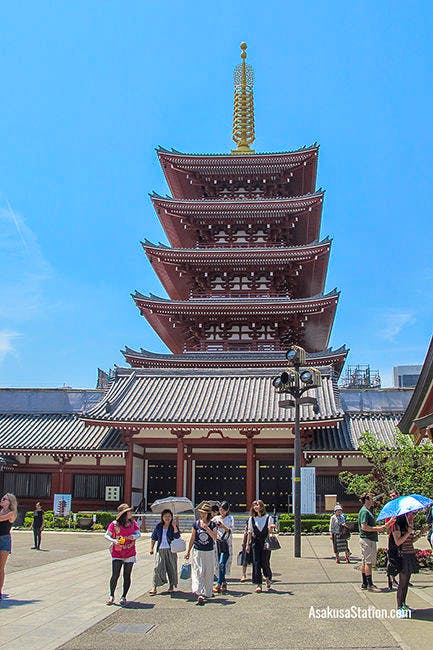
The Five-storied Pagoda
The Five-storied Pagoda, called Goju-no-to in Japanese, was first built in 942, rebuilt in 1648 by the shogun Tokugawa Iemitsu, and destroyed by the bombing in 1945. The current pagoda dates from 1973 and has a traditional form, but a very modern steel framed structure of ferroconcrete and it stands 53.32 meters high. Although it is now located on the left as you approach the Main Hall, before the war it was located on the right. The practice of building pagodas developed from the Indian tradition of building stupas to hold sacred relics. Sensoji’s pagoda has a relic of the Buddha’s ashes in its topmost story that was donated by the Isurumuniya Temple in Sri Lanka in 1966.
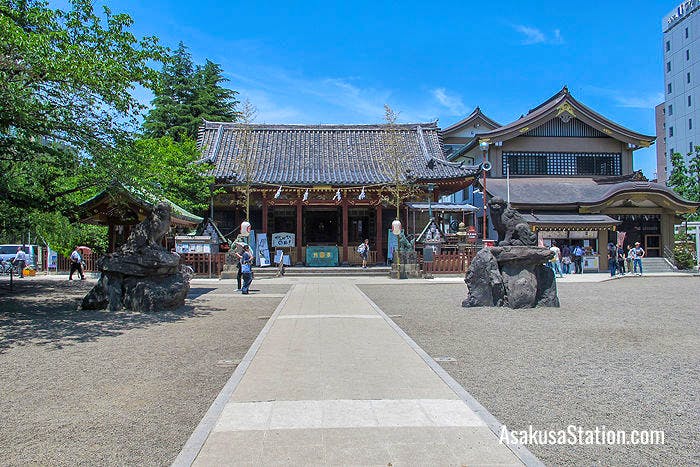
Asakusa Jinja Shrine
After visiting Sensoji Temple, a short walk to the east will take you to nearby Asakusa Jinja Shrine, which is much smaller and quieter than Sensoji, but full of interesting details. The shrine is actually dedicated to the two brothers and their chief who established Sensoji 1,400 years ago. To read more about it, see our article: Asakusa Jinja Shrine.
The Main Hall of Sensoji Temple is open between 6.00 and 17.00, but opens at 6.30 between October and March. The main buildings of Sensoji are illuminated every evening. The temple grounds are much quieter at this time, so this is a great time to take some pictures.
Sensoji Temple Location Map
The Sensoji temple complex occupies a large area in the center of Asakusa. The main entrance for Sensoji is through the Kaminarimon Gate which is located on Kaminarimon Dori. It is a 1 minute walk Exit 1 of Tokyo Metro Asakusa Station, a 2 minute walk from the A4 Exit of Toei Asakusa Station, 3 minutes from Tobu Asakusa Station, and 8 minutes from TX Asakusa Station on the Tsukuba Express Line.
Article and original photos by Michael Lambe. All rights reserved.
